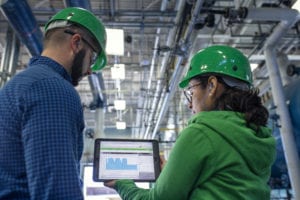Even while industrial plants worldwide are facing new challenges in the new normal, their need to operate efficiently is still a top priority. Energy and operational costs still need to be controlled and sustainability goals still need to be met to ensure compliance with emissions standards (a point I explored in an earlier blog). To meet these requirements, you need timely, detailed, and accurate information about your plant’s energy consumption. This is what a digitized electrical infrastructure and power management solution can deliver. But to go from good to great requires a formalized energy management program that helps your team understand and act on that information.
ISO 50001: Guiding Your Power Management Plan for Energy Efficiency
ISO 50001 is a voluntary international standard and recognized framework to establish, implement, maintain, and improve an energy management system. It helps your organization follow a systematic approach for achieving continual improvement of energy performance by setting energy reduction targets. It was reported in 2019 that over 18,000 companies worldwide had been certified to ISO 500001, representing over 42,000 sites. This does not include the many companies using the framework but not yet certified. Though most sites are industrial, the standard is being increasingly adopted by commercial facilities.
The framework defines a method for tracking energy performance based on selected key performance indicators (KPIs). These can include energy use or cost per unit of production or per unit of revenue, or the efficiency of specific processes or equipment, for example. Data gathered from integrated power management and process automation systems will support these KPIs.
Schneider Electric Plants: Case Studies with Proven Success

Over 10 years ago, in 2009, we enrolled as a Better Buildings, Better Plants Challenge Partner with the U.S. Department of Energy, with a first challenge goal of 25 percent reduction over 10 years. I am proud to say that by the end of 2016 (two full years early), we achieved our goal of 25 percent reduction and signed up for another challenge to reduce the energy consumption of our U.S. sites by 20 percent more in 12 years (by 2028).
A key part of this achievement has been the progressive implementation of ISO 50001 and the associated Department of Energy Superior Energy Performance (SEP) program across many of our manufacturing plants. We now have 20 sites in North America certified to ISO 50001, with most of those certified to SEP, six of which are at the Platinum level. James Hisey, Schneider Electric’s Energy Action Program Leader for North America, has said, “With each plant, it becomes easier to apply the SEP framework and generate real savings that persist over time.” In addition to our energy reduction performance, we demonstrated that our ISO 50001 certified sites experienced nearly double the savings as non-certified sites over a four-year period.
Schneider Electric has used its own IIoT-based EcoStruxure platform to support these efforts in every plant. These smart, connected solutions have been core to a digital transformation to a ‘Smart Factory’ model, for which we continue to be recognized. Our Smart Factory in Lexington, Kentucky has recently earned the distinction of 4th Industrial Revolution (4IR) Advanced Lighthouse by the World Economic Forum (WEF). It is the third Schneider Electric factory to receive this honor. The Lexington site continues to set new benchmarks for efficiency, with energy savings of 3.4 percent year-over-year, contributing to $6.6 million in savings since 2012.
The Big Payback from Best Practices
An energy management program guided by ISO 50001 can address a broad spectrum of efficiency analyses, such as:
- Relating energy costs more accurately to production costs
- Allocating energy costs to units of production, and reporting metrics on departmental energy usage, separating production from facilities energy usage
- Isolating and categorizing the cost of energy during various non-production periods
- Giving plant personnel visibility into energy waste in manufacturing processes, such as processes idled, starved, or blocked
- Comparing energy costs across plants to find good and bad performers
By correlating manufacturing processes to energy usage, hidden energy savings will often be revealed. For example, in one of our plants we achieved 31 percent savings by reducing energy waste in our paint line ovens. A series of savings like this can really add up. But to measure these gains, you will need a power management system in place, including the appropriate metering, software, and services. The good news is that, based on our experience, payback periods can often be as short as two to six months. This return on investment considers energy-related savings, but there is a good chance your power management system will also help you find additional operational savings through reduced maintenance costs, extended equipment lifespans, and increased uptime.
In addition, following ISO 50001 framework helps instill best practices as part of your corporate culture, with stakeholders across your organization taking ownership for efficiency and continuous improvement. By using an enterprise-wide approach, Schneider Electric was also able to reduce implementation time and accelerate the number of sites where ISO 50001 was implemented each year.
A Blueprint for Success
Your organization’s first steps to an ISO 50001 program will include several important questions to help you plan your strategy:
- What are the processes or machines for which you need to measure energy consumption?
- Does any metering exist? If yes, is there a complete monitoring infrastructure already in place?
- What are the processes or machine controls, e.g. PLCs or discrete I/O?
- What documentation exists, e.g. process flows, power studies, one lines, etc.?
- How are the results tracked, e.g. energy units or cost comparisons?
Once established in one plant, your program will be a blueprint for success across additional plants. With a solid framework driving best practices, supported by the best technology and expert services, you can look forward to meeting your operational and sustainability goals much faster. And if you are fortunate enough to achieve recognition for your successes, you will also enhance your brand.
Our EcoStruxure™ Power platform is certified for compliance with ISO 50001/2/6. This includes our award-winning EcoStruxure Power Monitoring Expert software and a wide range of smart metering devices. The platform supports comprehensive energy monitoring, analysis, and reporting, as well as tools to help optimize facility uptime, maintenance, and operational efficiency.



